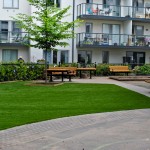
Subbase of synthetic turf
What is a good subsurface for synthetic turf?
Different names for the subsurface of synthetic turf are being used, like substructure, foundation, subsoil or sub base. They all refer to the same thing. For the best results, synthetic turf needs to be installed on a subsurface that is stable, even and permeable and has a load bearing capability. The structure can be compared with the subsurface of decorative paving. Of course, there are several options. Which option is the best is hard to tell as it also depends on the future use and the current condition of the soil. Below we will discuss the most common types of subsurface used for synthetic turf.
(If there is already a natural grass lawn in place, this needs to be removed first.)
Installing artificial grass on top of sand
In many cases, a bed of yellow sand (the kind of sand pavers use) of 10 to 15 centimetres will be sufficient. The thickness depends on the condition of the ground. For instance, a poorly permeable clay soil will need a thicker layer than a well permeable sandy soil.
The final result is determined by how well the sand is settled so there is no air left in the sand bed, for instance by spraying, and afterwards shivering and flattening the surface. After all of this, the artificial grass can be installed. A sand subsurface is more susceptible to sinking than a stronger foundation of debris or concrete (see previous paragraphs).
A slightly more expensive option is crusher dust. This is not really sand but gravel that has been ground (crushed) into sand. Because of the angular shapes it is a firmer subsurface than pavers’ sand. It is recommended not to use filler sand as this is often not permeable enough.
Synthetic turf on top of a hardened subsurface
A hardened subsurface is a subsurface that can handle heavier loads thanks to the use of crushed rubble, also called mixed granulate or repac. This type of foundation is also used for driveways and roads. In this case the subsurface consists of 2 layers. The underlay of crushed rubble and a thin finish layer of sand to make it even. The thickness of the layer of crushed rubble varies from 8 to 15 centimetres; the finish layer varies between 2 to 4 centimetres. This subsurface is used when the synthetic turf will be loaded heavily.
A similar construction can also be used for lava. The advantage of lava is that it is light. This can be useful especially for the installation of synthetic turf on a rooftop terrace or a roof garden. Another advantage of lava is that is can be ordered in finer gradations (e.g. 0-8). This way the foundation can be built and finished with only one layer. If you do not have any experience with making this type of foundation we recommend you to hire an expert.
In addition, foundation materials like bottom ash (from electric plants) and sand from furnaces are available. These are the materials constructors and specialists use. The functional value is mostly the same. Please consult your supplier for more information.
Synthetic turf on top of sand cement
Sand cement is also often used. For this underlay, sand is mixed with cement. The ratio sand/cement is very important. If it consist of too much cement, the mixture will not be permeable enough. Applying and evening the sand cement can also be a tricky task. Only experts should make a foundation of sand cement. Once applied this is the perfect foundation as it will not sink and can be loaded heavily.











